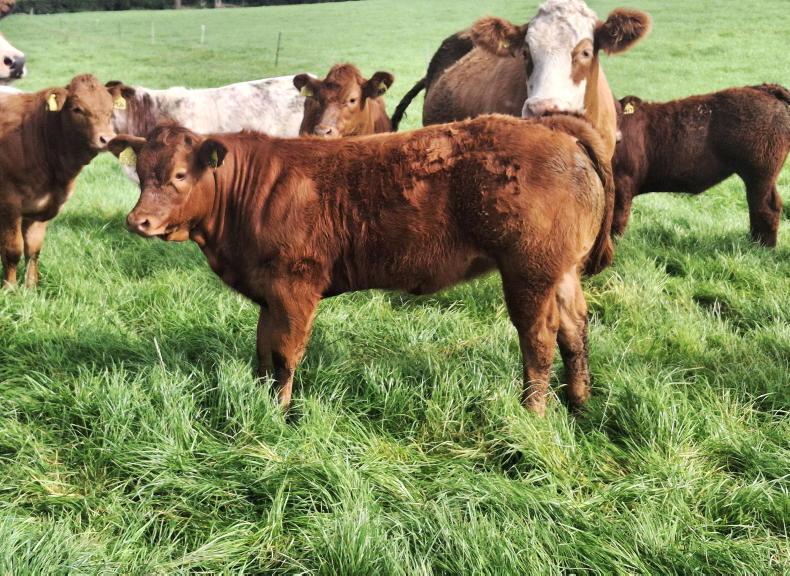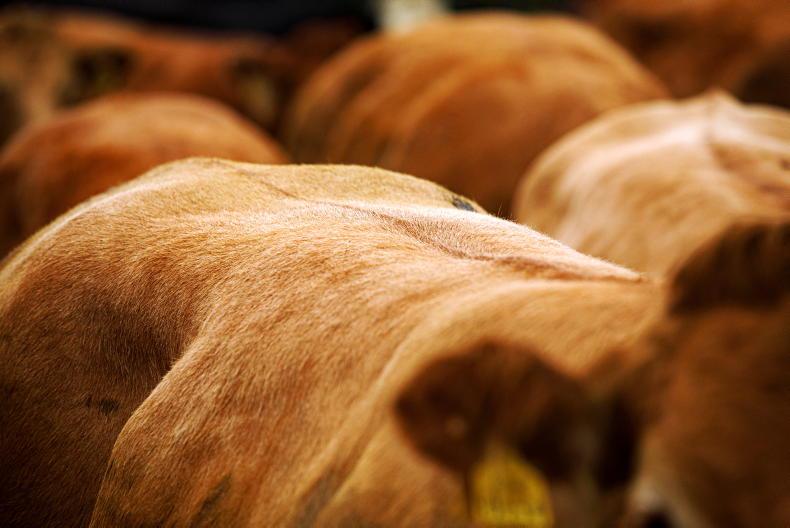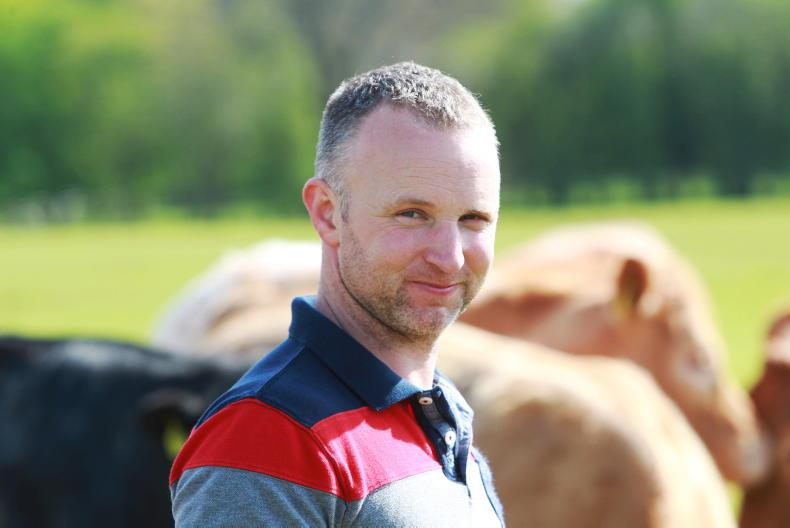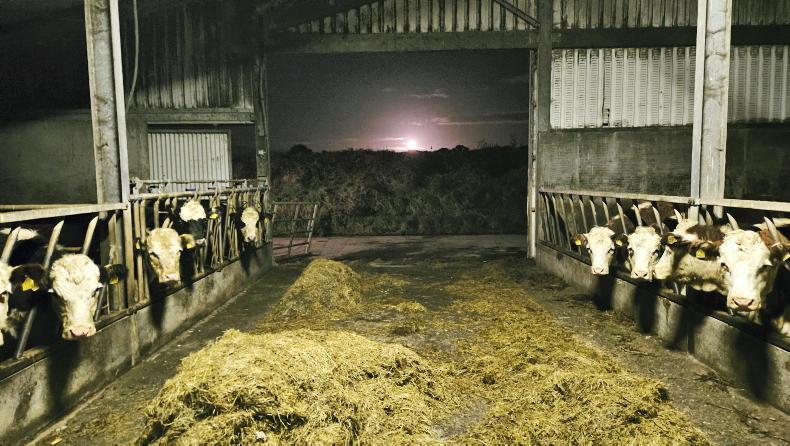The majority of Ireland’s suckler farms are family-run operations. Small farms with small numbers of cows form the backbone of rural Ireland, particularly in the west of the country.
Fermanagh has a long tradition of producing top-end suckler calves and marts such as Enniskillen and Clogher have impressive lineups of suckler-bred weanlings for sale at this time of year.
Fermanagh has a lot of heavy soils and this means most of the land in Fermanagh is allocated to suckler farming. Davy Boles farms with his wife, son and three daughters just outside Lisbellaw in Co Fermanagh.
Like Cavan, there is lots of water all around, with lakes and rivers, and last Thursday when I visited the Boles family, there was also lots of water falling from the sky and underfoot.

David Boles and Davy Boles.
“You don’t fight with the land around here,” Davy said, laughing.
“When the ground gets wet, you house the cattle. It’s as simple as that. We are used to long winters around here, so you make enough fodder to do you for a seven- month winter. They don’t always come but one came last year and you need to have enough fodder made for that. It looks like it’s going to be another one this year as well.”
Some spring-calving cows had already been housed when I was on the farm last Thursday as the rain pelted of the shed.

A typical Simmental cross cow with a Charolais calf at foot on the Boles farm.
“We housed the cows and let the calves come in and out to the field. We feel that works well to keep calves healthy. Calves work themselves on to some meal when they come in to suck the cows and that keeps the stress levels down and avoids any sickness or pneumonia.”
Davy is a part-time farmer and part-time fencing contractor. He works locally, with the majority of his work coming from local farmers in the form of farm fencing but he also completes wooden fencing jobs around houses.
Suits the system
The job suits the system in that if there is a cow calving, he’s never that far away and can pop home to calve a cow if he needs to. Not that help is scarce at home.
Davy’s three daughters, Claire, Katie and Grace, and son, David, all play an active part in the farm. It’s rare to see everybody in a family with an interest in farming but that’s the way it is in the Boles household.

Davy's Charolais bull Heathvale Roberto sired by Goldstar Othello.
Claire Boles plays with the Irish women’s Sevens team and is just back from Paris where she made her Olympic debut.
“You could see any of them scraping down cubicles here on a Saturday morning. They all live their own lives but they like to come back and do a bit of farming in their free time.
“They all have their strengths and interests.

Some of Davy's replacement Limousin heifers
“Katie is very good at calving cows. She just has that experience when she puts a hand into a cow to tell you whether it’s going to come. I know there are people who will say nobody should be handling a cow when she is calving but when you are looking for that top 5% to 10% weanling you are always going to make sure everything is OK at calving time,” Davy says.
When you can only keep small numbers, the quality has to be high and that’s the way a lot of farmers have been moving over the last few years, especially where they are working on tough ground.
Talking to farmers in marts recently, everybody is on the same track. Reduce cow numbers and keep better stock. Yes, the risk is higher if things go wrong, but the reward can also be high keeping better stock.

A Chocolat d'Ochamps heifer calf.
Davy likes the Limousin breed when it comes to breeding suckler cows.
“It’s hard to beat the Limousin for that bit of length. The Limousin bring you that nice twist of muscle too. I also like the Simmental. They are good for milk and also bring that little bit of quietness into cattle, I think.”
Limousin and Simmental cross cows are crossed with a terminal sire Charolais bull to produce the weanlings that Davy wants. It’s a combination that’s working, with Davy regularly taking home top prices at local weanling sales during the year.
Davy also took home first prize in the 2023 Enniskillen show society competition for Fermanagh suckler herd of the year.
Davy has also had past success at fatstock sales in Clogher Mart and the winter fair formerly known as Allams Show. “It’s hard to beat the Charolais, in my opinion. I sometimes see lads crib and crab about paying €2,000 for a stock bull and I think, he’s half your herd.

Some of Davy's weanlings destined for the autumn weanling sales.
“In my opinion, it pays to go that extra mile when you are buying a bull. We bought our current Charolais bull in Mayo a few years ago and he’s doing a real good job for us. We got £1,480 (€1,761) for a 370kg weanling last year and regularly hit £4/kg for our weanlings.”
Davy also dabbles a bit in AI and is currently preparing a weanling off the famous Chocolat d’Ochamps bull for a winter fatstock show and sale.
“We get a kick out of doing well at these special shows and sales and it’s great for the whole family to get involved. That’s what it’s all about.”
The future
“There’s lots of people giving out about suckling and the low margins but, for me, if you can keep the quality up, then there’s a margin in it. We’ll stick at what we are doing. We won’t chop and change and we’ll keep trying to breed them better each year.”
Farm size: 85 acres (split across three blocks).Cow number: 30.System: suckler to weaning (autumn and spring).Breeds: Limousin, Simmental and Charolais.Location:
Lisbellaw,
Co Fermanagh.
The majority of Ireland’s suckler farms are family-run operations. Small farms with small numbers of cows form the backbone of rural Ireland, particularly in the west of the country.
Fermanagh has a long tradition of producing top-end suckler calves and marts such as Enniskillen and Clogher have impressive lineups of suckler-bred weanlings for sale at this time of year.
Fermanagh has a lot of heavy soils and this means most of the land in Fermanagh is allocated to suckler farming. Davy Boles farms with his wife, son and three daughters just outside Lisbellaw in Co Fermanagh.
Like Cavan, there is lots of water all around, with lakes and rivers, and last Thursday when I visited the Boles family, there was also lots of water falling from the sky and underfoot.

David Boles and Davy Boles.
“You don’t fight with the land around here,” Davy said, laughing.
“When the ground gets wet, you house the cattle. It’s as simple as that. We are used to long winters around here, so you make enough fodder to do you for a seven- month winter. They don’t always come but one came last year and you need to have enough fodder made for that. It looks like it’s going to be another one this year as well.”
Some spring-calving cows had already been housed when I was on the farm last Thursday as the rain pelted of the shed.

A typical Simmental cross cow with a Charolais calf at foot on the Boles farm.
“We housed the cows and let the calves come in and out to the field. We feel that works well to keep calves healthy. Calves work themselves on to some meal when they come in to suck the cows and that keeps the stress levels down and avoids any sickness or pneumonia.”
Davy is a part-time farmer and part-time fencing contractor. He works locally, with the majority of his work coming from local farmers in the form of farm fencing but he also completes wooden fencing jobs around houses.
Suits the system
The job suits the system in that if there is a cow calving, he’s never that far away and can pop home to calve a cow if he needs to. Not that help is scarce at home.
Davy’s three daughters, Claire, Katie and Grace, and son, David, all play an active part in the farm. It’s rare to see everybody in a family with an interest in farming but that’s the way it is in the Boles household.

Davy's Charolais bull Heathvale Roberto sired by Goldstar Othello.
Claire Boles plays with the Irish women’s Sevens team and is just back from Paris where she made her Olympic debut.
“You could see any of them scraping down cubicles here on a Saturday morning. They all live their own lives but they like to come back and do a bit of farming in their free time.
“They all have their strengths and interests.

Some of Davy's replacement Limousin heifers
“Katie is very good at calving cows. She just has that experience when she puts a hand into a cow to tell you whether it’s going to come. I know there are people who will say nobody should be handling a cow when she is calving but when you are looking for that top 5% to 10% weanling you are always going to make sure everything is OK at calving time,” Davy says.
When you can only keep small numbers, the quality has to be high and that’s the way a lot of farmers have been moving over the last few years, especially where they are working on tough ground.
Talking to farmers in marts recently, everybody is on the same track. Reduce cow numbers and keep better stock. Yes, the risk is higher if things go wrong, but the reward can also be high keeping better stock.

A Chocolat d'Ochamps heifer calf.
Davy likes the Limousin breed when it comes to breeding suckler cows.
“It’s hard to beat the Limousin for that bit of length. The Limousin bring you that nice twist of muscle too. I also like the Simmental. They are good for milk and also bring that little bit of quietness into cattle, I think.”
Limousin and Simmental cross cows are crossed with a terminal sire Charolais bull to produce the weanlings that Davy wants. It’s a combination that’s working, with Davy regularly taking home top prices at local weanling sales during the year.
Davy also took home first prize in the 2023 Enniskillen show society competition for Fermanagh suckler herd of the year.
Davy has also had past success at fatstock sales in Clogher Mart and the winter fair formerly known as Allams Show. “It’s hard to beat the Charolais, in my opinion. I sometimes see lads crib and crab about paying €2,000 for a stock bull and I think, he’s half your herd.

Some of Davy's weanlings destined for the autumn weanling sales.
“In my opinion, it pays to go that extra mile when you are buying a bull. We bought our current Charolais bull in Mayo a few years ago and he’s doing a real good job for us. We got £1,480 (€1,761) for a 370kg weanling last year and regularly hit £4/kg for our weanlings.”
Davy also dabbles a bit in AI and is currently preparing a weanling off the famous Chocolat d’Ochamps bull for a winter fatstock show and sale.
“We get a kick out of doing well at these special shows and sales and it’s great for the whole family to get involved. That’s what it’s all about.”
The future
“There’s lots of people giving out about suckling and the low margins but, for me, if you can keep the quality up, then there’s a margin in it. We’ll stick at what we are doing. We won’t chop and change and we’ll keep trying to breed them better each year.”
Farm size: 85 acres (split across three blocks).Cow number: 30.System: suckler to weaning (autumn and spring).Breeds: Limousin, Simmental and Charolais.Location:
Lisbellaw,
Co Fermanagh.
















SHARING OPTIONS